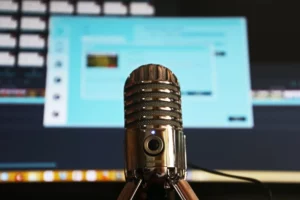One of the most important parts of recording a podcast episode is your podcast call to action. This simple component – which often takes the form of just a few sentences – is critical toward helping you build a brand and achieve your goals. In this article, we explain how to podcast calls to action work and how to create your own.
What is a Podcast Call to Action?
A podcast call to action (CTA) is when you ask your listeners to take some kind of action. It’s an important way to help them engage with your brand and support your overall goals.
Here are some examples:
- Share the episode with their friends
- Rate or review the show on their listening app
- Visit a page on your website
- Become a member of your Patreon
- Click a link in your show notes
How often should you have a call to action?
Every episode, without exception. In fact, you should prompt your audience to take action every time you engage with them, whether that’s an email marketing campaign, social media promotion, webinar, membership course, or blog post.
You may feel foolish saying the same CTA in every episode, but your audience won’t mind. Keep in mind that your show isn’t as important to them as it is to you, so they won’t remember every single word. Besides, research shows that repetition makes them more likely to take action.
If you still feel silly, come up with a few variations of the same CTA so you aren’t using the same phrase over and over. ChatGPT is a great tool to spin a sentence into unique variations.
Where should you place a call to action?
You can put a podcast call to action anywhere you like in your episode. You have total control. It’s a good idea to insert your CTAs wherever they seem most reasonable. For instance, if your conversation mentions merchandise, you should use that opportunity to plug your T-shirt line.
That said, CTAs are most effective in three places in your episode – the same places that sponsors want to be mentioned (which is no surprise).
- Pre-Roll – This is the beginning of your episode. The majority of listeners will hear it, but may not take action right away because they’re engrossed in the episode.
- Mid-Roll – This is the middle of the episode (though not necessarily the exact middle). At this point, listeners are immersed in the episode and aren’t likely to abandon it, so this is a valuable position as well.
- Post-Roll – This is the very end of the episode and a unique position. Many listeners leave the episode as soon as they hear “wrapping up” language, but those who stay are highly interested. If they hear a CTA, they’ll take action because there’s nothing keeping them glued to the episode any longer.
The Different Types of Podcast CTA
You probably won’t use the same podcast call to action in each episode. Over time, your needs will change and you’ll start asking your audience to take different steps.
For instance, in the beginning, you’ll practically beg your listeners for ratings and reviews. But once you have a few hundred reviews, you’ll feel comfortable shifting your attention to different goals.
A podcast call to action comes in two types: general and specific.
General Podcast CTAs
General calls to action refer to your broad, overall goals. These are the engagements that help your brand grow. They are simple, easy for your audience to understand, and easy for you to repeat regularly.
Here are some examples of general podcast calls to action:
- “Check out our website for more information.”
- “Click the share button in your app to send this episode to a friend.”
- “Review our show to help us grow.”
- “Visit our Patreon to learn how you can get exclusive benefits.”
- “Follow me on Twitter for early updates.”
In most cases, a general CTA helps you, but doesn’t do much for your listeners. You’re asking for a favor to meet your own goals. These CTAs should apply to all listeners, regardless of the app they’re using, and appear in your show’s intro or outro.
Specific Podcast CTAs
Specific podcast calls to action refer to short-term goals that you want your audience to help you achieve. These are usually relevant to specific campaigns, events, or initiatives.
Here are some examples of specific podcast calls to action:
- “Visit our store to buy our new merch.”
- “Take a survey to help us understand our audience better.”
- “Support our cause by donating to this charity.”
- “Purchase our new ebook on Amazon.”
- “Meet us at our event in San Antonio.”
Since there’s an element of time here, you’ll want to repeat your specific CTAs more often. Don’t worry about overwhelming your audience because once the campaign or event ends, you’ll move on to something different.
In order to encourage your audience to take action quickly, make sure they benefit somehow from your specific calls to action. Your audience should get something by helping you out.
If your specific CTA has any deadlines or dates, make sure to include them as well. “Sign by December 1st for our meet-up on March 10th.”
How to Craft an Effective Podcast Call to Action
Now that you understand what a podcast called to action is and how they work, let’s talk about writing your own. These tips will help you create an effective podcast called to action that drives your audience to take the next step.
1. Keep your CTA short and simple
Short calls to action are easier for you to say and for your listeners to understand. They are more likely to do what you ask if those instructions are simple.
That said, don’t be afraid to be specific, just put it in a way that’s easy to remember. For instance, instead of asking them to “Review us on Apple Podcasts,” you might say something like, “Please give us 5-stars on Apple Podcasts.” That’s specific, but still simple.
2. Describe the benefits of the action
Whenever you ask someone to take action, it’s important to explain how it benefits them. Your audience will be more willing to participate if they feel like they get something out of the deal as well.
For instance, suppose you want your listeners to take a survey that will help you generate content for upcoming episodes. Instead of asking them for their feedback, which only helps you, encourage them to “help shape the podcast.” Instead of asking them to buy your ebook, prompt them to “learn the skills they need to start a business.”
3. Limit the Number of CTAs
Your audience isn’t going to spend 20 minutes completing a list of tasks, so it’s important to limit the number of calls to action in your episode. Ideally you should prompt your listeners to take action no more than twice during an episode. Place these CTAs at different points so listeners don’t feel like you’re giving them too much to do.
4. Create a page for additional instructions
If you want your listeners to perform a specific action that’s too hard to explain on a podcast episode, consider creating a page podcast website that outlines the steps they should take.
For example, suppose you’re working with a charity to help their cause. Instead of listing all of the ways your audience can help that charity, send them to a page that lists the steps and provides links to take action. This lets you keep your in-episode CTA as simple as possible.
Use a simple URL for this page that’s easy to say and remember. Use “mydomain.com/charity” or “mydomain.com/membership” so they’re impossible to forget.
5. Create a sense of urgency
If you ask a listener to take an action, but don’t give them a deadline, they’ll probably think, “I’ll get around to it when I can.” But if you add a sense of urgency, you can entice them to take that step now, otherwise they experience some kind of pain or fail to receive a benefit.
For instance, you might say, “Our sponsor is offering this special discount to you guys, but the sale ends on November 3rd. Make sure to place your orders soon before you miss the chance.”
Or you push on a pain they’re already dealing with: “Grab our parenting workbook before school starts to help your kids make the transition.”
6. Put your CTA in your show notes
Your podcast show notes are another opportunity to engage with your audience. If they’re browsing your notes, they obviously care about the content of your episode, so this is a great chance to push your podcast call to action.
Plus, since your show notes exist as a web page, you can include links to whatever you’re promoting.
7. Focus on the next logical step
Your podcast call to action should relate to the overall topic of your podcast. For instance, the host of a marketing podcast would reasonably prompt their listeners to sign up for a private marketing coaching session. But it wouldn’t make sense to prompt those same listeners to download a cookbook or attend a local car show.
8. Be proud of what you offer
Many podcasters are uncomfortable with self-promotion because they feel like they are imposing on their audience. While it’s true that too many CTAs can frustrate your audience, listeners expect some CTAs and won’t perceive you as too promotional.
Take pride in what you offer. If you believe in the call to action, you will make a good argument for it. And if you promote it genuinely, your audience will believe it’s good as well. Just make sure to explain why the promotion benefits them.
Use the Podcast Call to Action That Works Best
As you publish episodes, experiment with different CTAs. Change up your phrasing, tone, and placement of your calls to action. Then watch your metrics to determine the ones that work best. If a particular CTA drives good engagement consistently, use it more often.
What kind of podcast call to action do you use? Let us know in the comments.
Featured image by Jernej Furman on Flicker. (Creative Commons)




